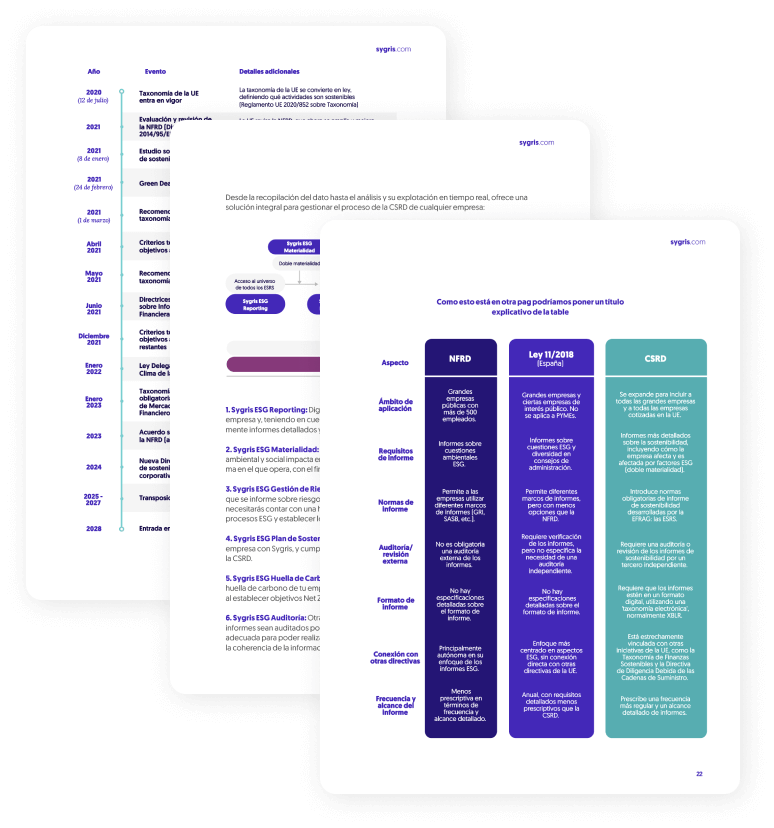While the CSRD (Corporate Sustainability Reporting Directive) has gained traction, many companies are still underestimating the magnitude of the shift required by this new regulatory framework. The process of mastering CSRD is complex and, in many cases, still unfamiliar. Despite efforts to clarify its scope, no one has a complete understanding of what compliance truly means. What is clear, however, is that there is a long road ahead.
How Did We Get Here?
The introduction of Law 11/2018 in Spain, which transposed the European NFRD (Non-Financial Reporting Directive), was not entirely successful in its early years due to various challenges. In 2018, the framework required around 1,600 large companies (with more than 500 employees) to begin reporting non-financial information, but many faced difficulties due to a lack of experience and clarity around reporting requirements. According to a CNMV report, early submissions were inconsistent and lacked depth, as many companies had not fully adopted frameworks like the Global Reporting Initiative (GRI), resulting in hard-to-compare information.
In the first few years, the quality and accuracy of the reports gradually improved. Between 2019 and 2020, companies started adjusting their internal processes, and the adoption of sustainability standards such as GRI became more common. The mandatory shareholder vote on reports, a unique requirement of Spanish law, also helped draw more attention to the quality of the information presented.
By 2020, more than 1,600 companies were more effectively complying with Law 11/2018, and various studies indicated a significant increase in the number of companies improving the depth and accuracy of their reports. Nevertheless, there was still a notable gap between sectors. For instance, sectors like food production showed significant improvements in sustainability reporting, while others, such as industry, struggled more to adapt.
The evolution since then has been marked but limited. While large companies managed to improve the quality of their reports by 2021, the introduction of the CSRD presents a much greater challenge. This new directive not only expands the scope to over 45,000 companies but also requires stronger alignment with the EU’s sustainability goals and external verification of data, raising the bar significantly compared to Law 11/2018.
The shift from Law 11/2018 to the CSRD reflects a significant increase in the complexity of reporting obligations. While the earlier law required detailed disclosure of non-financial information such as environmental and social aspects, the CSRD raises the standards even further. Unlike the Spanish law, the CSRD requires the application of much stricter reporting frameworks and a higher level of data verification, also broadening the range of companies required to report, including medium-sized enterprises and more sectors. The biggest challenge lies in aligning with more rigorous international standards, such as those developed by the ISSB, and in deeply integrating sustainability into a company’s core business model, rather than simply providing superficial reports.
For CSRD implementation to be fully effective, companies will need to significantly strengthen their capacity to collect, process, and verify sustainability data. Moreover, they must develop strategies that clearly align with the goals of the European Green Deal and the transition to a carbon-neutral economy. All of this would be unimaginable without the pivotal role of technology. Although traditional reports tend to be repetitive in their structure and content, the CSRD marks a turning point, demanding an urgent transformation in how organisations manage their information.
Technological Challenges of the CSRD
What makes the CSRD truly disruptive is not just the volume of data and delivery timelines but the complete shift in reporting dynamics. This is no longer a process that can be managed using traditional methods. The only viable way to tackle this challenge is through investment in technology. Without it, companies will face serious difficulties in meeting the imposed requirements. The technological challenges become the central focus of this transformation, and to overcome them, a robust infrastructure and appropriate tools will be required.
- Building new data models: The first key challenge is constructing new data models within organisations. To comply with the CSRD, companies need a data container capable of integrating information from multiple sources—ranging from Excel spreadsheets to more complex data from ERP or CRM systems. All of this information flow must be centralised and managed efficiently, requiring a complete rethinking of how corporate data is handled.
- XBRL taxonomy for reporting: Another crucial challenge is generating reports using the XBRL taxonomy. This specific format allows data to be structured and tagged in compliance with regulatory demands. Although it may seem like just another format, it actually requires a significant restructuring of how companies prepare their reports, ensuring that data is properly tagged and ready for submission.
- European Single Access Point (ESAP) submissions: The submission process is another critical point. Companies will need to upload their reports to the European Single Access Point (ESAP), the new centralised platform for non-financial information in Europe. This unified system will serve as the reference for corporate sustainability tracking across the EU. This means companies must not only prepare the report but also ensure it meets the requirements for acceptance into ESAP, where it can be easily compared to reports from other companies.
- Increased audit demands: Finally, audits present another major challenge. These will be mandatory, much more detailed, and more demanding. Companies will need to invest more time and resources to ensure that their reports meet the new standards and can pass this stricter scrutiny.
The Solution to Address This Challenge
The CSRD represents an unprecedented challenge for companies in terms of data management and regulatory compliance. As organisations prepare to meet this directive, it’s clear that attempting to address it with manual processes or traditional tools would be ineffective and, in many cases, unfeasible. The sheer volume of information to be gathered, structured, and presented, combined with specific format requirements such as the XBRL Taxonomy and the obligation to upload reports to platforms like ESAP, demands a technological solution capable of managing all these aspects comprehensively.
Having a platform that can centralise data from multiple sources—such as ERP, CRM, or simple spreadsheets—is crucial for consolidating information coherently and traceably. On top of this, automating the generation of reports in standard formats and ensuring these reports are ready for submission to the relevant authorities without errors is essential. Additionally, with increasingly thorough audits, having a system that facilitates traceability, version control, and data transparency becomes vital to reduce errors and optimise the review and verification process.
In this scenario, Sygris Reporting positions itself as an integrated solution to tackle these challenges. The platform enables the centralisation and management of data from various sources, such as Excel, ERP, CRM, and other internal systems, providing a global and structured view of the information. Moreover, Sygris offers automated management of the 1,100+ data points required by the CSRD, facilitating their classification, control, and real-time monitoring. The generation of reports in XBRL format is fully automated, ensuring compliance with all tagging and structuring requirements imposed by European regulations. Another key aspect of Sygris Reporting is its capacity to manage the entire audit and verification process, offering complete traceability of all collected and processed data. This makes the auditor’s job easier and reduces the effort required by the company. The platform also allows organisations to customise their workflows and adapt to regulatory changes quickly, ensuring a smooth transition to the new regulatory framework while maintaining control over the information.
Sygris not only optimises reporting processes but also becomes a strategic partner in ensuring compliance with the CSRD, saving valuable time and resources at every stage of the process.




